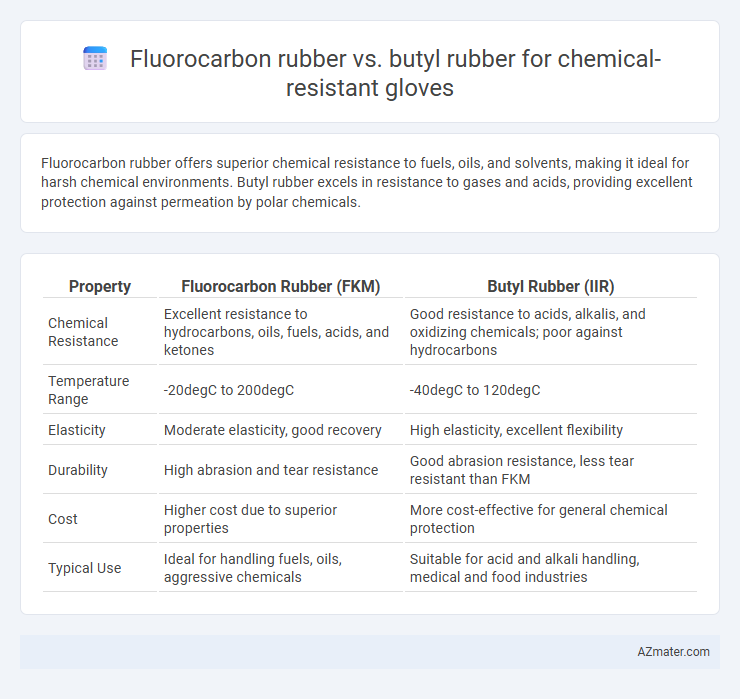Fluorocarbon rubber offers superior chemical resistance to fuels, oils, and solvents, making it ideal for harsh chemical environments. Butyl rubber excels in resistance to gases and acids, providing excellent protection against permeation by polar chemicals.
Table of Comparison
| Property | Fluorocarbon Rubber (FKM) | Butyl Rubber (IIR) |
|---|---|---|
| Chemical Resistance | Excellent resistance to hydrocarbons, oils, fuels, acids, and ketones | Good resistance to acids, alkalis, and oxidizing chemicals; poor against hydrocarbons |
| Temperature Range | -20degC to 200degC | -40degC to 120degC |
| Elasticity | Moderate elasticity, good recovery | High elasticity, excellent flexibility |
| Durability | High abrasion and tear resistance | Good abrasion resistance, less tear resistant than FKM |
| Cost | Higher cost due to superior properties | More cost-effective for general chemical protection |
| Typical Use | Ideal for handling fuels, oils, aggressive chemicals | Suitable for acid and alkali handling, medical and food industries |
Introduction to Chemical-Resistant Gloves
Chemical-resistant gloves require materials like Fluorocarbon rubber and Butyl rubber to provide superior protection against hazardous chemicals and solvents. Fluorocarbon rubber offers excellent resistance to oils, fuels, and a wide range of chemicals due to its low permeability and high durability. Butyl rubber excels in resisting gases, ketones, and esters, making it crucial for handling highly corrosive substances in industrial and laboratory settings.
Overview of Fluorocarbon Rubber
Fluorocarbon rubber (FKM) offers superior chemical resistance compared to butyl rubber, particularly against oils, fuels, and solvents, making it ideal for protective gloves in harsh chemical environments. Its exceptional thermal stability, withstanding temperatures up to 200degC, enhances durability and longevity in industrial applications. While butyl rubber excels in resistance to gases and acids, fluorocarbon rubber provides a broader spectrum of protection, especially against aggressive hydrocarbons and oxidative chemicals.
Overview of Butyl Rubber
Butyl rubber is a synthetic copolymer known for its excellent resistance to gases, chemicals, and extreme temperatures, making it highly suitable for chemical-resistant gloves. Its impermeability to gases and resistance to acids, alkalis, and oxidizing agents enhance protection in hazardous environments. Compared to fluorocarbon rubber, butyl rubber offers superior resistance to polar solvents but has lower resistance to hydrocarbons and oils.
Chemical Resistance: Fluorocarbon vs Butyl Rubber
Fluorocarbon rubber exhibits superior chemical resistance compared to butyl rubber, especially against oils, fuels, and aromatic hydrocarbons, making it ideal for handling aggressive chemicals. Butyl rubber offers excellent resistance to polar solvents, acids, and alkalis but is less effective against aromatic and chlorinated solvents. Selecting fluorocarbon gloves enhances durability and protection in environments with harsh chemicals, while butyl gloves provide reliable defense against a broad range of inorganic chemicals.
Temperature Performance Comparison
Fluorocarbon rubber gloves exhibit exceptional temperature resistance, maintaining chemical integrity from -20degC up to 200degC, making them suitable for high-temperature chemical applications. Butyl rubber gloves, while providing excellent resistance to gases and chemicals, perform effectively within a narrower temperature range of -40degC to 120degC, limiting their use in extreme heat environments. The superior thermal stability of fluorocarbon rubber enhances glove durability and protection in scenarios involving elevated temperatures and aggressive chemical exposure.
Mechanical Properties and Durability
Fluorocarbon rubber exhibits superior mechanical properties such as high tensile strength and excellent abrasion resistance, making it highly durable for chemical-resistant gloves exposed to harsh solvents and oils. Butyl rubber, while offering exceptional impermeability and resistance to gases, generally has lower tensile strength and abrasion resistance compared to fluorocarbon rubber, leading to reduced mechanical durability under abrasive conditions. The enhanced durability of fluorocarbon rubber gloves under mechanical stress ensures longer service life in industrial environments requiring robust chemical protection.
Permeation Rates and Breakthrough Time
Fluorocarbon rubber offers significantly lower permeation rates and longer breakthrough times compared to Butyl rubber when used in chemical-resistant gloves, making it highly effective against a wide range of aggressive solvents and fuels. Butyl rubber exhibits moderate chemical resistance with faster permeation rates, especially to ketones and esters, resulting in shorter breakthrough times. Therefore, for applications involving prolonged exposure to harsh chemicals, fluorocarbon rubber gloves provide superior protection and durability.
Cost and Availability Considerations
Fluorocarbon rubber gloves offer superior resistance to a wide range of chemicals but tend to be more expensive and less readily available than butyl rubber gloves, which provide excellent protection against gases and chemicals at a lower cost. Butyl rubber gloves are commonly mass-produced, ensuring greater availability and affordability for large-scale applications. Cost-sensitive industries often prefer butyl rubber gloves due to their balance of chemical resistance and budget-friendly pricing compared to the premium pricing of fluorocarbon rubber options.
Application Suitability in Various Industries
Fluorocarbon rubber excels in applications requiring high resistance to fuels, oils, and aggressive chemicals, making it ideal for automotive, aerospace, and chemical processing industries. Butyl rubber offers superior impermeability to gases and excellent resistance to acids, alkalis, and ketones, fitting well in pharmaceutical manufacturing, food processing, and environmental protection sectors. Choosing between fluorocarbon and butyl rubber gloves depends on the specific chemical exposure and industry standards, ensuring optimal protection and durability.
Choosing the Right Glove Material for Chemical Protection
Choosing the right glove material for chemical protection requires understanding the specific properties of fluorocarbon rubber and butyl rubber. Fluorocarbon rubber offers superior resistance to solvents, oils, and fuels, making it ideal for handling aggressive chemicals and petrochemicals. Butyl rubber excels in providing excellent impermeability against gases and acids, making it suitable for environments involving ketones, esters, and strong acidic vapors.

Infographic: Fluorocarbon rubber vs Butyl rubber for Chemical-resistant glove
 azmater.com
azmater.com